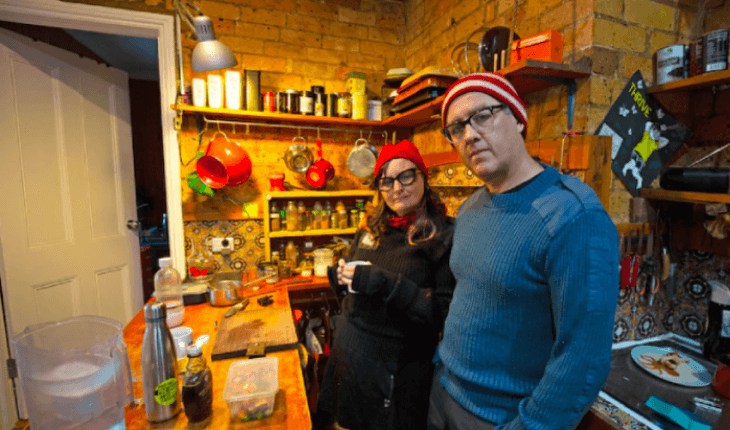In Amity and Mickie’s rental home in Sydney, there’s a room connected to the main living space by a doorway that has no door.
A note stuck to the wall reveals the family’s pet name for this room: ‘Antarctica’.
“It’s got a ceiling that’s just plastic sheeting and no insulation,” Mickie tells ABC RN Breakfast.
“It’s absolutely freezing.”
Mickie has wedged a rod above the doorway and draped a heavy curtain to try to halt the cold air wafting in, but it’s not having much of an impact.
It’s just one of the small modifications the family has made as they shiver through a second winter in a house they otherwise love.
And the conditions are taking a toll.
“I feel like the cold really impacts my mental health, probably more than my physical health,” Amity says.
“I find it just really affects my mood, being cold.”
Despite this, the family hasn’t asked for any changes to the property to fix the problem because they don’t want to put their landlord offside and risk eviction.
But they are taking part in a national project, run by community organisation Better Renting, which is investigating just how cold Australian homes get. Their rental is one of 70 sites that has been monitored through winter for about seven weeks.
The project organisers gave the renters temperature monitoring devices to test how often their homes were below 18°Celsius. This is the recommendation set by the World Health Organization for a “safe and well-balanced” indoor temperature for a home during winter.
Results so far are concerning.
For example, one night Amity put on three heaters at once, in one part of the house, to see how much she could warm it up.
She only got the temperature to 17°C.
Not built for winter
Other tenants taking part in the temperature monitoring project are also struggling to heat their homes to the recommended level, according to Joel Dignam, the founder and executive director of Better Renting.
“Even in some relatively warmer parts of Australia, the average temperatures are still really low. So in New South Wales and Victoria, the average temperature in the rental properties we’re tracking is still below 18°C,” Mr Dignam says.
Temperature trackers give Better Renting round-the-clock data from the 70 sites as parts of the county endure an unusually cold winter.
In the first fortnight, the data showed the homes were below 18°C for 70 per cent of the time.
The coldest temperature recorded so far was 1°C, logged by a participant living in their car in Hobart.
Those with a roof over their head have logged temperatures as low as 6°C.
Professor Emma Baker, who heads up the Housing and Healthy Cities Research Group at the University of Adelaide, says the data collected by Better Renting is concerning but not surprising.
It matches a 2019 study she was part of that looked at 35 homes in South Australia. None of them reached 18°C in winter.
“Power used to be really cheap so Australian houses were basically designed as winter tents that you could pump a whole lot of energy into during winter and warm them up,” Prof. Baker says.
But that’s no longer an option for many renters as power bills soar.
Researchers are also showing greater interest in the links between cold homes and health.
“We know that cold housing affects people’s blood pressure and their risk of cardiovascular disease, and obviously respiratory disease,” Prof. Baker says.
“But the really interesting thing that’s been coming up lately is mental health.
“Mental health seems to be the canary in the mine, the thing that is affected first by having cold housing.”
Participants in the Better Renting project have been asked about the impact their homes’ temperature is having on their health and wellbeing. Ten of the 56 who responded mentioned mental health issues related to their home temperature.
“Our mental health is affected by the cold house,” one renter responded.
“I had to stay in bed, under the blanket, to study and do my homework or read a book at night as it is too cold.”
Prof. Baker says work by the Australian Centre for Housing Research shows cold housing can “tip” otherwise healthy people into having mental health issues.
“It might be via worry about not being able to afford to heat your home, or the drudgery of living in an uncomfortable living environment, or the sadness of not being able to provide your kids warmth,” she says.
Calls for better housing standards
Joel Dignam says the project shows the need to set minimum standards for the heating and insulation of rentals across the country.
He points to a new Victorian minimum standard mandating energy-efficient fixed heaters be installed in rental properties by next year, and an ACT proposal for minimum standards on ceiling insulation.
The Real Estate Institute of Australia (REIA) opposes mandating standards. REIA president Hayden Groves warns it would force some owners out of the market and ultimately push up rental prices.
“It can be very difficult to retrofit a building to make it more energy efficient, if it’s at a certain age. And it can be prohibitively expensive,” he says.
“If you mandate these sorts of things, you run into the problem where property owners consider, ‘Look, it’s just another expense that I have to spend on the property, I’ll sell it’.”
Instead, Groves encourages tenants to ask their landlords to make modifications and potentially offer to help install or pay for them.
But if you need help sooner, there are tricks out there you can try to keep warmer this winter, like DIY window insulation, sealing up leaks and indoor rugs and door snakes.
 � 2020 Australian Broadcasting Corporation. All rights reserved.
� 2020 Australian Broadcasting Corporation. All rights reserved.
ABC Content Disclaimer

